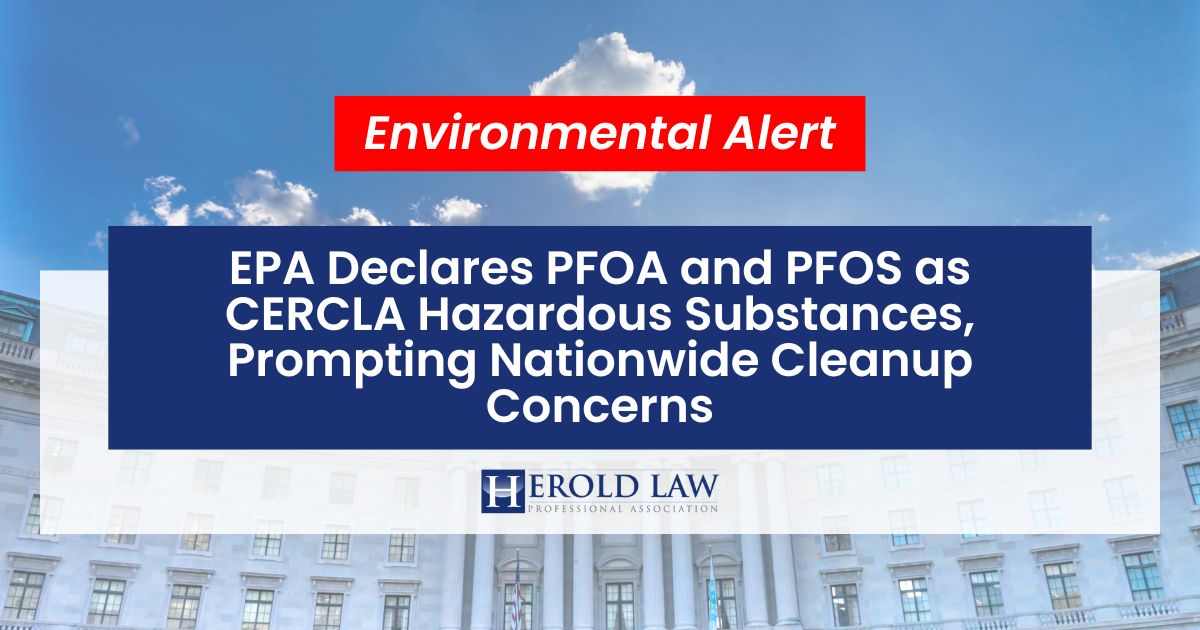EPA Designates PFOA and PFOS as CERCLA Hazardous Substances

On April 19, 2024, the United States Environmental Protection Agency (EPA) announced its new final rule designating two PFAS, also known as “forever chemicals,” perfluorooctanoic acid (PFOA) and perfluorooctanesulfonic acid (PFOS), as hazardous substances under the Comprehensive Environmental Response, Compensation and Liability Act (CERCLA).[1] This action, which comes on the heels of the EPA’s April 10, 2024 release of its Final National Primary Drinking Water Regulation[2] governing PFOA, PFOS and four other PFAS compounds, has the possibility of exposing a wide range of manufacturers, users and processors of PFOA and PFOS and landowners with PFOA and PFOS to Superfund cleanup liability across the country.
This was EPA’s first time ever using Section 102(a) of CERCLA to add a substance (or two, in this instance) to the list of existing hazardous substances located in Table 302.4 of 40 CFR part 302. Up until this new rule, substances have only been added to the CERCLA list after being deemed hazardous under other federal environmental statutes, like the Clean Water Act or Resource Conservation and Recovery Act (RCRA).
Capturing PFOA and PFOS under the wide net of CERCLA statutory lability will have significant impacts on companies and cleanup sites moving forward. Facilities will now be required to report releases of PFOA and PFOS at or above their “reportable quantity” within a 24-hour period, which is one pound or more for both substances. In addition, the new rule will authorize the EPA to order cleanups and recover responses costs related to PFOA and PFOS under CERCLA, and will permit potentially responsible parties (PRPs) to seek similar types of costs and/or contribution from other PRPs.
Additionally, this new rule will have implications on the sale of properties that are the subject of Phase 1 Environmental Site Assessments, as PFOA and PFOS will now be in scope pursuant to ASTM E1527-21 and need to be considered to satisfy the “All Appropriate Inquiry” liability protection standard established under CERCLA. Moreover, parties must be aware that this new rule could impact the CERCLA five-year review process for remediated sites containing hazardous substances above levels that permit unlimited use and unrestricted exposure, as the EPA may elect to re-assess whether the selected remedy continues to be protective of human health and the environment.
With the rolling out of this new rule, the EPA also developed and issued a CERCLA PFAS enforcement discretion and settlement policy.[3] Under that policy, the EPA states that it “does not intend to pursue entities where equitable factors do not support seeking response actions or costs under CERCLA, including, but not limited to, community water systems and publicly owned treatment works, municipal separate storm sewer systems, publicly owned/operated municipal solid waste landfills, publicly owned airports and local fire departments, and farms where biosolids are applied to the land.” However, the “EPA will focus on holding accountable those parties that have played a significant role in releasing or exacerbating the spread of PFAS into the environment, such as those who have manufactured PFAS or used PFAS in the manufacturing process, and other industrial parties.”
The final rule will be published by the EPA in the Federal Register shortly and will become effective 60 days after its publication.
Notably, this rule was developed and published as part of the EPA’s PFAS Strategic Roadmap, which was originally published in 2021.[4] The Roadmap outlines a number of ongoing efforts the EPA has taken and still plans to take by the close of this year to combat the health and environmental risks associated with PFAS. Below is a brief summary of recent PFAS-related actions taken by the EPA and the Biden administration that businesses should be aware of today:
- Final National Primary Drinking Water Regulation: On April 10, 2024, the EPA issued federal regulatory limits on PFAS in drinking water. Under this new rule, EPA will set a Maximum Contaminant Level Goal (MCLG), which is a non-enforceable health-based goal, of zero for both PFOA and PFOS. EPA will also be setting an enforceable Maximum Contaminant Level (MCL) of 4 parts per trillion (ppt) for PFOA and PFOS, individually, and MCLGs and MCLs of 10 ppt for PFNA, PFHxS, and HFPO-DA/GenX Chemicals.
- Proposal to List Nine PFAS as RCRA Hazardous Constituents: On February 8, 2024, the EPA proposed changes to RCRA regulations by adding PFOA, PFOS and seven other PFAS, along with their respective salts and structural isomers, to the list of hazardous constituents in Title 40 of the Code of Federal Regulations Part 261, Appendix VIII.[5]
- New Methods for Measuring PFAS in the Environment: In January 2024, the EPA released three methods to better measure PFAS in wastewater and other environmental media:
- Final EPA Method 1633: “a method to test for 40 PFAS in wastewater, surface water, groundwater, soil, biosolids, sediment, landfill leachate, and fish tissue.”
- Final EPA Method 1621: “which can broadly screen for the presence of chemical substances that contain carbon-fluorine bonds, including PFAS, in wastewater.”
- Other Test Method-50: “which measures 30 volatile fluorinated compounds in air.”
- Seven Additional PFAS Added to the Toxic Release Inventory (TRI): As of June 2023, nine PFAS were added to the TRI list. In January 2024, seven additional PFAS were automatically added as well.[6]
- Significant New Use Rule: Also in January 2024, the EPA finalized a rule preventing businesses from starting or resuming the manufacture or processing of 329 PFAS that have not been made or used for many years without a complete EPA review and risk determination.[7]
- $9 Billion in Funding Secured to address PFAS and other emerging contaminants of concern: Through the Bipartisan Infrastructure Law, upwards of $9 Billion dollars has been secured by the Biden Administration to help states and territories implement PFAS testing and treatment at public water systems and to help owners of private wells address PFAS contamination.
- TSCA Section 8(a)(7) Reporting and Recordkeeping Requirements for PFAS: In October 2023, EPA published its final rule regarding updated reporting and recordkeeping requirements for PFAS under the Toxic Substances Control Act.[8]
As can be seen from above, the PFAS landscape is rapidly changing. Our team of experienced environmental attorneys at Herold Law, P.A. will continue to closely monitor these new developments and are available to answer any questions you may have.
For questions on the recent actions by the EPA, please contact:
John J. McAleese, III, Esq. (610) 977-2023 | [email protected]
Anthony J. Reitano, Jr., Esq. (908) 647-1022 | [email protected]
Connor E. Phalon, Esq. (908) 647-1022 | [email protected]
[1] https://www.epa.gov/system/files/documents/2024-04/pre-publication_final-rule-cercla-pfoa-pfos-haz-sub.pdf
[2] https://www.epa.gov/system/files/documents/2024-04/pfas-npdwr_prepubfederalregisternotice_4.8.24.pdf
[3] https://www.epa.gov/system/files/documents/2024-04/pfas-enforcement-discretion-settlement-policy-cercla.pdf
[4] https://www.epa.gov/system/files/documents/2021-10/pfas-roadmap_final-508.pdf
[5] https://www.govinfo.gov/content/pkg/FR-2024-02-08/pdf/2024-02324.pdf
[6] https://www.epa.gov/system/files/documents/2024-01/list-of-pfas-added-to-the-tri-by-the-ndaa.pdf
[7] https://www.govinfo.gov/content/pkg/FR-2024-01-11/pdf/2024-00412.pdf
[8] https://www.govinfo.gov/content/pkg/FR-2023-10-11/pdf/2023-22094.pdf




 908-679-5011
908-679-5011



